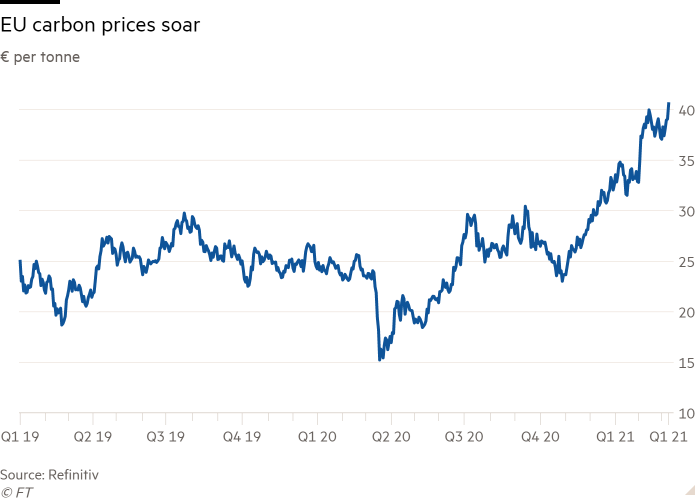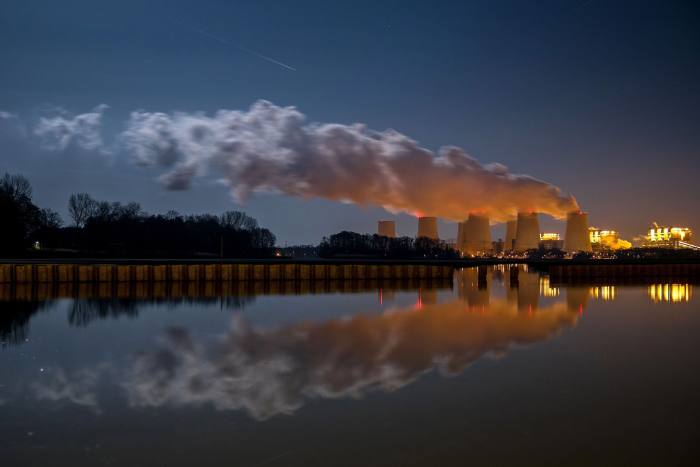New US climate strategy opens up old faultlines with Europe
The Biden administration marked the US return to international climate leadership this week with ambitious plans to halve greenhouse gas emissions by 2030. But the move also resurfaced some old faultlines.
The climate goal put the US broadly on par with the EU, which this week sealed the terms of a European law that commits the bloc to reducing emissions by at least 55 per cent over the decade, against 1990 levels. The US goal is based on 2005 emission levels.
Although cheered on in Europe, the US climate comeback masks divergent approaches between the two economic powerhouses on how to win the so-called race to net zero.
“The Americans have a strategy based on the development of new technologies,” France’s environment minister Barbara Pompili told the FT this week. “It’s great to develop hydrogen, as we are doing, and carbon capture. But I think we have an extra ingredient in France and Europe. We’re going further because we’re also looking at our ways of life.”
EU officials are also quick to point out what they see as gaps in the US strategy which relies heavily on new green technologies and private sector innovation and investment to radically drive down emissions.
“I’m genuinely optimistic. I believe in our ingenuity,” US presidential climate envoy John Kerry said on Thursday, in the aftermath of the first day of the American-led climate summit which drew leaders from 40 countries including China’s Xi Jinping and Russia’s Vladimir Putin, as well as fresh climate pledges from Japan, Canada and South Korea.
Kerry said he expected the US to exceed its 2030 goal on the back of yet-to-be-developed technological advances in areas such as green hydrogen power, batteries, and carbon capture and storage.
“We are the country that went to the moon. We didn’t know how we were going to get there when President Kennedy announced the goal, but we did it”, said the former secretary of state.
EU officials admit that the US can mobilise far more investment into green technologies compared to the 27-country bloc, where spending is still nationally determined.
But the US’s “techno-optimism” stands in stark contrast to the EU’s multipronged approach which combines a mix of the bloc’s regulatory might and investment in energy innovations, plus an advanced system of carbon pricing, to spur the consumer changes needed to drastically cut emissions.
The EU used the Trump years to establish itself as the world’s foremost climate superpower. Brussels climate law enshrines its binding target of net zero emissions by 2050 — which, if achieved, would make the EU the first continent in the world to reach the milestone.
In the coming months, Brussels will set out green legislation to make the bloc “fit for 55 per cent” by 2030. The laws will touch on everything from car emission targets and buildings renovations to renewable energy, as part of a European Green Deal that is hailed as an industrial policy to revive the post-pandemic economy.
Sandrine Dixson-Declève, co-president of the Club of Rome, says the EU climate strategy is a “systems approach” which attempts to encompass almost all sectors of the economy. “The US has always been driven by the market — and not just the Biden administration. They are missing a trick by not focusing on shifting the economy beyond using technological levers.” she says.
US policy analysts concur that America is still playing catch-up on climate policy, even if Biden administration officials insist that broad technological gains ensure that not too much ground was lost in the Trump years.
“A key difference is that many European countries have passed climate legislation, and this gives them much more authority to design and implement policies consistent with their international commitments” says Kelly Sims Gallagher, a former senior Obama White House official who helped negotiate the 2014 US-China climate accord. “The US lacks this comprehensive legislation and instead has pursued a patchwork approach with limited authorities”.
“[The Biden Administration] is perhaps underestimating the scepticism from the international community that the US can get back on track with its domestic policy.”
One of the biggest points of departure between the two powers is Europe’s embrace of carbon pricing through its market-driven Emissions Trading Scheme (ETS) which sits at the heart of Europe’s decarbonisation plan.
The ETS was set up in the 2000s to incentivise heavy polluting industries to switch to greener power by forcing them to buy carbon allowances to compensate for their emissions. The cap-and-trade scheme is due to undergo a radical expansion to include new sectors such as shipping, carmakers and buildings, and force further changes across the business models of European industry. In anticipation, investors have driven the carbon price to fresh records this week of upwards of €40 per tonne.
But such a market-based system has won little federal level support in the US, despite a smaller carbon trading scheme being adopted in California, and, to a more limited degree, in north-eastern states such as New York and Maryland.
“If the Americans don’t have a carbon pricing system, the only alternative is a carbon tax and that is political suicide,” said a senior EC official.
Countering US claims that Europe is fixated on regulation, EU policymakers say the ETS has proven to be a successful market-driven solution that has prevented over-regulation and stringent standard setting in areas such as energy efficiency.
“We are baffled as to why the US is allergic to it and don’t think they have really thought it through” added the official.

EU-US tensions over carbon pricing risk coming to a head over the most contentious area: Brussels’ planned carbon border adjustment tax which is designed to slap levies on imports from countries without equivalent carbon price mechanisms.
Kerry has resisted European efforts to get the US to join the scheme, and has warned it should only be used as a “last resort”. The commission’s proposal will be unveiled in June.
Divergent climate philosophies are likely to remain given the fundamentally different political landscapes in the US and EU. In spite of splits among the EU’s 27 member states on energy policy, all have signed up to its net zero target and the need for decarbonisation.
By contrast, environmental policy in the US risks being caught in the crossfire of a deeply polarised party politics, with supportive Democrats and resistant Republicans, said the Club of Rome’s Dixson-Declève.
Jeff Colgan, associate professor of the climate solutions lab at Brown University, said Europe “shouldn’t expect” the US to follow the policy mix seen in the UK and EU. “The US has different politics and Biden has to follow the art of the possible to get good climate policies.”
Additional reporting by James Politi in Washington
Follow @ftclimate on Instagram
Climate Capital

Where climate change meets business, markets and politics. Explore the FT’s coverage here

